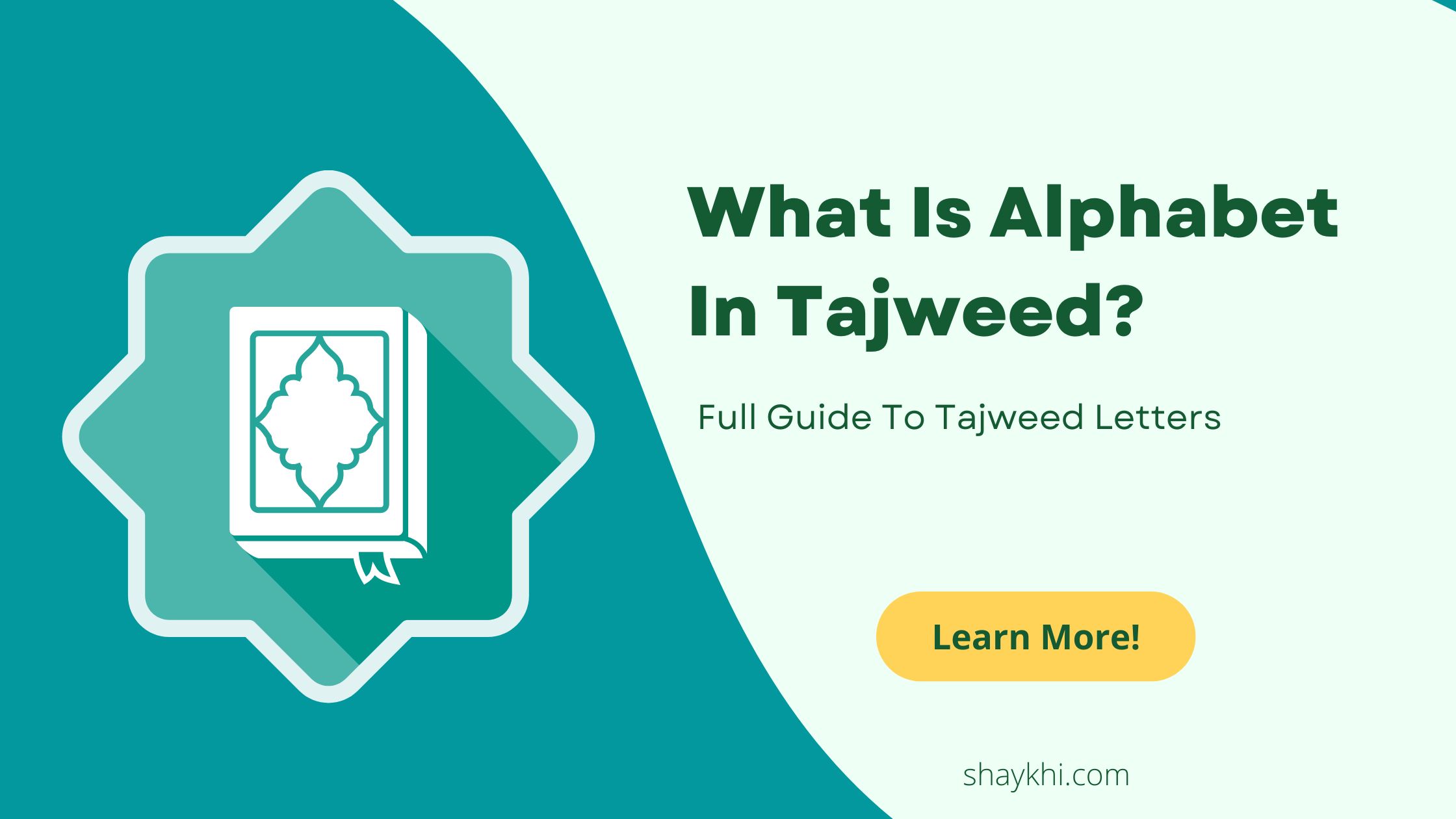The Arabic language is the language of the Quran, and thus the words of the Quran are composed of Arabic alphabet letters. Tajweed scholars differentiate between the Arabic alphabet in the Arabic language and the Arabic alphabet in terms of Tajweed.
As is known, there are 28 letters in the Arabic alphabet, but in the science of Tajweed, most scholars agree that there are 29 letters. Each of these letters has one specific articulation point from which it is pronounced and several characteristics ascribed to it by scholars within the context of Tajweed.
Alphabet in Arabic
The letters of the Arabic language have many features, as the Arabic language is rich in details. Each letter has a distinct form in writing, which is the shape it takes when written (ا – ب – ت – ج – ح – خ – د – ذ…).
Each letter also has a name, which is the letter’s designation when pronounced without diacritical marks (با – تا – ثا – جيم – دال – زاى – همزة – لام – واو).
Additionally, each letter has a pronunciation with diacritics. For instance, the letter جَ is pronounced as “jeem with a fathah,” fully articulating the vowel sound and not just as “jeem.”
Alphabet in Tajweed
In Tajweed, the Arabic alphabet consists of 29 letters, beginning with the hamza as a separate letter. Each letter has an articulation point from which it is pronounced and multiple attributes.
Characteristics of Arabic Letters in Tajweed
| Letter | The Letter Characteristics |
| Alif (أ) | Five attributes: Voiced, Softness, Lowering, Openness, Non-articulated |
| Baa (ب) | Six attributes: Voiced, Strength, Lowering, Openness, Fluent, Vibration |
| Taa (ت) | Five attributes: Whispered, Strength, Lowering, Openness, Non-articulated |
| Thaa (ث) | Five attributes: Whispered, Softness, Lowering, Openness, Non-articulated |
| Jeem (ج) | Six attributes: Voiced, Strength, Lowering, Openness, Non-articulated, Vibration |
| Haa (ح) | Five attributes: Whispered, Softness, Lowering, Openness, Non-articulated |
| Khaa (خ) | Five attributes: Whispered, Softness, Elevation, Openness, Non-articulated |
| Daal (د) | Six attributes: Voiced, Strength, Lowering, Openness, Non-articulated, Vibration |
| Dhaal (ذ) | Five attributes: Voiced, Softness, Lowering, Openness, Non-articulated |
| Raa (ر) | Seven attributes: Voiced, Intermediacy, Lowering, Openness, Fluent, Deflection, Repetition |
| Zaa (ز) | Six attributes: Voiced, Softness, Lowering, Openness, Non-articulated, Whistling |
| Seen (س) | Six attributes: Whispered, Softness, Lowering, Openness, Non-articulated, Whistling |
| Sheen (ش) | Six attributes: Whispered, Softness, Lowering, Openness, Non-articulated, Diffusion |
| Saad (ص) | Six attributes: Whispered, Softness, Elevation, Closure, Non-articulated, Whistling |
| Dhaad (ض) | Six attributes: Voiced, Softness, Elevation, Closure, Non-articulated, Lengthening |
| Taa (ط) | Six attributes: Voiced, Strength, Elevation, Closure, Non-articulated, Vibration |
| Zhaa (ظ) | Five attributes: Voiced, Softness, Elevation, Closure, Non-articulated |
| Ayn (ع) | Five attributes: Voiced, Intermediacy, Lowering, Openness, Non-articulated |
| Ghayn (غ) | Six attributes: Voiced, Strength, Elevation, Openness, Non-articulated, Vibration |
| Kaaf (ك) | Five attributes: Whispered, Strength, Lowering, Openness, Non-articulated |
| Lam (ل) | Six attributes: Voiced, Intermediacy, Lowering, Openness, Fluent, Deflection |
| Meem (م) | Five attributes: Voiced, Intermediacy, Lowering, Openness, Fluent |
| Noon (ن) | Five attributes: Voiced, Intermediacy, Lowering, Openness, Fluent |
| Haa (ه) | Five attributes: Whispered, Softness, Lowering, Openness, Non-articulated |
| Waw (و) | Five attributes: Voiced, Softness, Lowering, Openness, Non-articulated (sixth attribute of leniency if it is silent after an opening) |
| Yaa (ي) | Five attributes: Voiced, Softness, Lowering, Openness, Non-articulated (sixth attribute of leniency if it is silent after an opening) |
| The three letters of elongation (أ, و, ي) | Five attributes: Voiced, Softness, Lowering, Openness, Non-articulated |
The Articulation Points of Letters (مخارج الحروف):
The articulation point is the place from where the letter originates and is distinguished from others. To determine the articulation point of a letter, pronounce it with a sukoon (silence) or a shadda (emphasis) after a hamzatul wasl (connecting hamza) with any vowel, then listen carefully.
Where the sound of the letter stops is its articulation point. Articulation points can be general, encompassing one or more points, or specific, encompassing only one articulation point.
Most Tajweed scholars, including Ibn al-Jazari (ابن الجزري) and Al-Khalil ibn Ahmad (الخليل بن أحمد), have stated that there are 17 specific articulation points, confined within five general articulation points.
General and Specific Articulation Points (مخارج الحروف العامة والخاصة)
The articulation points of letters are divided into two main categories: general articulation points and specific articulation points, totaling five points.
Al-Jawf (الجوف):
Includes one specific articulation point:
This is the hollow space within the throat and mouth, from which the following letters are pronounced:
- Alif Maddiyyah (ا) when preceded by a fathah, as in “قَالَ” (Qala – said).
- Ya Maddiyyah (ي) when preceded by a kasrah, as in “قِيلَ” (Qeela – it was said).
- Waw Maddiyyah (و) when preceded by a dammah, as in “يَقُولُ” (Yaquulu – he says).
These letters are also known as:
- Jawfiyyah Letters (حروف جوفية) (letters that originate from the jawf).
- Maddiyyah Letters (حروف مدية) (letters that have an elongated sound).
- Haruf al-‘Illah (حروف العلة) (vowel letters) because they resemble the sounds made by a sick person.
Al-Halq (The Throat) (الحلق):
Includes three specific articulation points:
- Aqsa al-Halq (أقصى الحلق) (Deepest part of the throat): Produces the letters Hamza (ء) and Ha (ه).
- Wast al-Halq (وسط الحلق) (Middle of the throat): Produces the letters Ayn (ع) and Ha (ح).
- Adna al-Halq (أدنى الحلق) (Nearest part of the throat): Produces the letters Ghayn (غ) and Kha (خ).
All these letters are collectively called Halqiyyah Letters as they originate from the throat.
Al-Lisan (The Tongue) (اللسان):
Includes ten specific articulation points, producing eighteen letters:
- The deepest part of the tongue touching the soft palate: Produces the letter Qaf (ق).
- Just below the deepest part of the tongue touching the hard palate: Produces the letter Kaf (ك). These two are known as Lahwiyyah Letters because they originate near the uvula.
- Middle of the tongue touching the roof of the mouth: Produces the letters Jeem (ج), Sheen (ش), and Ya (ي) (when moving, as in “يَعْلَمُونَ” – Ya’lamoon – they know, “هَيِّنٌ” – Hayyin – easy, “يُؤْمِنُونَ” – Yu’minoon – they believe, or when the preceding letter has a fathah as in “خَيْرٌ” – Khayr – good). These letters are called Shajariyyah Letters as they originate from the mouth’s roof.
- Edges of the tongue touching the upper molars: Produces the letter Dhad (ض). The Dhad originates from one of the edges of the tongue touching the upper molars, either from the left side, which is easier and more commonly used, or the right side, which is less commonly used.
- Edge of the tongue near the upper canines: Produces the letter Lam (ل). The Lam is produced from the edge of the tongue touching the upper canines.
- Tip of the tongue touching the upper gums slightly behind the edge: Produces the letter Nun (ن).
- Tip of the tongue touching the upper gums slightly deeper than the Nun: Produces the letter Ra (ر). These three letters (Lam, Nun, and Ra) are called Dhalqiyyah Letters as they originate from the tip of the tongue.
- Tip of the tongue touching the roots of the upper incisors: Produces the letters Ta (ط), Dal (د), and Ta (ت), known as Nati’ah Letters as they originate from the upper palate.
- Tip of the tongue touching the area just above the lower incisors: Produces the letters Sad (ص), Zay (ز), and Seen (س). These letters are called Asliyyah Letters as they originate from the tip of the tongue.
- Tip of the tongue touching the edges of the upper incisors: Produces the letters Tha (ظ), Dhal (ذ), and Tha (ث). These letters are called Lathawiyyah Letters due to their close proximity to the gums.
Ash-Shafatan (The Lips) (الشفتان):
Includes two specific articulation points:
- The inner part of the lower lip touching the edges of the upper incisors: Produces the letter Fa (ف).
- Both lips together: Produces the letters Ba (ب) and Meem (م) when fully closed, and Waw (و) when partially closed. The Waw is articulated with the lips either open or closed. These letters are called Shafawiyyah Letters.
Al-Khayshoom (The Nasal Cavity) (الخيشوم):
Includes one specific articulation point:
Al-Khayshoom: The nasal cavity’s highest point from which the nasal sound (ghunnah) originates. This sound is inherent in the letters Nun (ن) and Meem (م) when pronounced with nasalization.
Characteristics of Arabic Letters (صفات الحروف)
The characteristics of Arabic letters (Sifaat Al Huroof In Tajweed) refer to the distinct features that are present when pronouncing each letter.
Scholars have varied in their opinions on the number of these characteristics. The majority, including Ibn Al-Jazari (ابن الجزري), have identified eighteen characteristics, as mentioned in Al-Jazari’s works.
Some scholars have reduced this number to fifteen by excluding Ismat, Ithlaq, and Leen, while others have expanded it to over forty by including additional characteristics. These characteristics are divided into two main categories:
Intrinsic Characteristics (صفات لازمة):
These are inherent to the letter and do not change, such as Voiced (Jahr) and Soft (Rikhwah) for specific letters.
Incidental Characteristics (صفات عرضية):
These characteristics can appear or disappear depending on the context, such as Emphasis (Tafkhim) and Lightness (Tarquik) in the letter Ra.
Intrinsic Characteristics of Letters (صفات الحروف اللازمة)
The intrinsic characteristics are further divided into two categories:
1. Characteristics with Opposites (صفات لها ضد):
These are characteristics that have opposing counterparts, influencing the pronunciation in different ways:
Voiced (Jahr) (الجهر) vs. Whispered (Hams) (الهمس)
Soft (Rikhwah) (الرخاوة) vs. Strong (Shiddah) (التوسط) and Intermediate (Tawasut)(التوسط)
The intermediate letters are five, indicating a state between strength and softness, as grouped in the saying “لن عمر” (“Lan Umar”).
Low (Istifal) (الاستفال) vs. High (Isti’la) (الاستعلاء)
Open (Infitah) (الانفتاح) vs. Closed (Itbaq) (الاطباق)
Non-articulated (Ismat) (الاصمات) vs. Articulated (Ithlaq)(الإذلاق)
Comparison between the characteristics of Arabic letters that have direct opposites
| Characteristic | Definition & letters | Opposite Characteristic | Definition & letters |
| Voiced (Jahr) | The vocal cords vibrate when pronouncing the letter.The voiced letters are the remaining Arabic letters after excluding the ten whispered letters. | Whispered (Hams) | The vocal cords do not vibrate when pronouncing the letter.The whispered letters are ten, as grouped in the saying of Al-Jazari: “فحثه شخص سكت” (“Fahathahu Shakhsun Sakata”) |
| Soft (Rikhwah) | The sound flows easily without interruption.The soft letters are sixteen, which are the remaining letters after excluding the strong and intermediate ones. | Strong (Shiddah) | The sound is tight and restricted.The strong letters are eight, as grouped in the saying: “أجد قط بكت” (“Ajd Qat Bakat”) |
| Low (Istifal) | The tongue is lowered from the roof of the mouth.The lowered letters are twenty-two, which are the remaining letters after excluding the elevated ones. | High (Isti’la) | The tongue is raised towards the roof of the mouth.The elevated letters are seven, grouped in “خص ضغط قظ” (“Khussa Dhaght Qizh”). |
| Open (Infitah) | The tongue is away from the roof of the mouth, creating an open sound.The open letters are twenty-five, which are the remaining letters after excluding the closed ones | Closed (Itbaq) | The tongue is close to the roof of the mouth, creating a closed sound.The closed letters are four, which are: ص, ض, ط, ظ (Sas, Dad, Ta, Za) |
| Non-articulated (Ismat) | The letter is not pronounced with fluency. The non-articulated letters are twenty-three, which are the remaining letters after excluding the fluent ones. | Articulated (Ithlaq) | The letter is pronounced with fluency and ease.The fluent letters are six, grouped in “فر من لب” (“Firr Min Lab”) |
2. Characteristics without Opposites (صفات لا ضد لها):
These characteristics do not have direct opposites and are unique to certain letters:
Whistling (Safeer) (الصفير):
This refers to a sound resembling the chirping of a bird produced while pronouncing the letter. It occurs with the letters ص, ز, and س.
Echoing (Qalqalah) (القلقة):
This involves the tongue shaking while pronouncing the letter, resulting in a strong sound, especially when the letter is in a sukoon (silent) state. The letters of qalqalah are gathered in the phrase “قُطْبُ جَدٍ.
Softness (Leen) (اللين):
This means the letter is pronounced with ease and without difficulty. There are two letters associated with leniency: the silent ya preceded by a fathah (e.g., عَيْنٍ), and the silent waw preceded by a fathah (e.g., قَوْمِ).
Inclination (Inhiraf) (الانحراف):
This occurs when the letter deviates from its articulation point to another. It applies to two letters: ل and ر.
Repetition (Takrir) (التكرير):
This is the vibration of the tongue’s tip when pronouncing the letter, which leads to its repetition, especially if it is silent or stressed. This only occurs with the letter ر.
Spreading (Tafasshee) (التفشي):
This refers to the spreading of air in the mouth when pronouncing the letter ش until it reaches the articulation point of the letter ظ. This characteristic is exclusive to the letter ش.
Lengthening (Istitaala) (الاستطالة):
This is the elongation of the articulation point when pronouncing the letter ض until it reaches the articulation point of the letter ل. This characteristic is exclusive to the letter ض.
Strength and Weakness of Letters (الحروف القوية والحروف الضعيفة)
Arabic letters are classified based on their characteristics into strong and weak letters. The more strong attributes a letter has, the stronger it is considered. Conversely, the more weak attributes a letter has, the weaker it is considered.
1. Strong Characteristics (صفات القوة في الحرف):
Examples include vibration (qalqalah) and elevation (isti‘laa).Strong Characteristics: Examples include vibration (qalqalah) and elevation (isti‘laa).
2. Weak Characteristics (صفات الضعف في الحرف):
Examples include leniency (leen) and softness (rakhaawah).Weak Characteristics: Examples include leniency (leen) and softness (rakhaawah).
Thus, Arabic letters are classified as either strong or weak based on their characteristics. The strength or weakness of a letter is determined by the number of strong or weak characteristics it possesses.
For instance, the strongest letter is ط, as all its characteristics are strong, while the weakest letter is ه, as all its characteristics are weak.Thus, Arabic letters are classified as either strong or weak based on their characteristics.
The strength or weakness of a letter is determined by the number of strong or weak characteristics it possesses. For instance, the strongest letter is ط, as all its characteristics are strong, while the weakest letter is ه, as all its characteristics are weak.
Method of Determining Letter Characteristics (طرق تحديد صفات الحرف)
To determine the characteristics of a letter, one should follow these steps: To determine the characteristics of a letter, one should follow these steps:
1. Check With hams and jahr
Check if the letter is among the whispered letters (hams) or voiced letters (jahr). If it is among the whispered letters, it is whispered; otherwise, it is voiced.Check if the letter is among the whispered letters (hams) or voiced letters (jahr). If it is among the whispered letters, it is whispered; otherwise, it is voiced.
2. Check the lintiant of the Letters:
Then check if the letter is among the strong (shadeed), intermediate (mutawassit), or soft (rakhee) letters. If it is among the strong letters, it is strong; if among the intermediate letters, it is intermediate; otherwise, it is soft. Then check if the letter is among the strong (shadeed), intermediate (mutawassit), or soft (rakhee) letters. If it is among the strong letters, it is strong; if among the intermediate letters, it is intermediate; otherwise, it is soft.
3. Check if it is an elevated (must’alee) or lowered (mustafeel) letter
Next, check if the letter is among the elevated (must’alee) or lowered (mustafeel) letters. If it is among the elevated letters, it is elevated; otherwise, it is lowered.Next, check if the letter is among the elevated (must’alee) or lowered (mustafeel) letters. If it is among the elevated letters, it is elevated; otherwise, it is lowered.
4. Check if the letter is one of the itbaa infitaah letters
Then check if the letter is among the letters of closure (itbaaq) or openness (infitaah).Then check if the letter is among the letters of closure (itbaaq) or openness (infitaah).
5. Check the Tafkheem and Tarqeeq of the Letters
Lastly, check if the letter is among the articulated (mufakham) or non-articulated (muraqqa) letters.Lastly, check if the letter is among the articulated (mufakham) or non-articulated (muraqqa) letters.
By following this sequence, a letter will have five characteristics. Then, one can look for additional characteristics that have no opposites, one by one. If the letter has one of these characteristics, it will have a sixth characteristic. This applies to the following letters: ص, ز, س, ق, ظ, ب, ج, ذ, the silent ya preceded by a fathah, the silent waw preceded by a fathah, ل, ش, and ض.By following this sequence, a letter will have five characteristics.
Then, one can look for additional characteristics that have no opposites, one by one. If the letter has one of these characteristics, it will have a sixth characteristic. This applies to the following letters: ص, ز, س, ق, ظ, ب, ج, ذ, the silent ya preceded by a fathah, the silent waw preceded by a fathah, ل, ش, and ض.
Learn Tajweed with Shaykhi Academy
Shaykhi Academy is dedicated to teaching the sciences of the Holy Quran and the Arabic language, offering professional and specialized lessons at various levels to suit your learning plan. Our skilled and professional teachers guarantee that you will improve your Tajweed and become more proficient in reciting the Quran.
You can access the learning materials anytime and from anywhere. Additionally, you can earn certificates from accredited teachers and obtain recognized Ijazahs in memorization, Tajweed, and recitation
Why Choose Shaykhi Academy?
- Connect with highly qualified native tutors.
- Flexible scheduling to suit your busy lifestyle.
- Affordable classes tailored for all levels.
- Accessible from anywhere around the globe.
Discover Our Range of Courses:
- Arabic Noorani Qaida: Lay a solid foundation for Quranic studies.
- Online Quran Classes for Kids: Engaging lessons for lifelong learning.
- Tajweed Rules for Kids: Learn to recite with confidence.
- Quran Hifz for Kids: Step-by-step guidance to memorize the Quran.
- Quran for Adults: Introduce yourself to Quran reading and Tajweed rules.
- Online Arabic Courses: Master the language of the Quran.
- Islamic Studies: A wide range of topics related to Islam, including theology, law, Quranic studies, and Hadith.
Don’t Miss Out on Your Chance to Excel! Whether you’re a beginner or seeking advanced knowledge, Shaykhi Academy can guide you! Book your free trial now

Conclusion
The Arabic language is rich in details, and as we have learned, each letter has an articulation point when pronounced, along with several distinguishing characteristics.
Letters may share one, two, three, or more characteristics, but each letter has between 5 to 7 characteristics, no more and no less. Based on the shared characteristics, we can classify them into similar letters, proximate letters, identical letters, and distant letters.
This classification is also useful in other Tajweed rules since every part of the science of Tajweed is closely related to the rest. Therefore, anyone who wants to learn Tajweed should start systematically, in a studied and gradual manner, to master the recitation of the Quran in the best and most beautiful way.
We ask Allah to make us among those who benefit from the Quran and its recitation, and to make learning and teaching the Quran a reward and virtue for us in this world and the hereafter.

















































